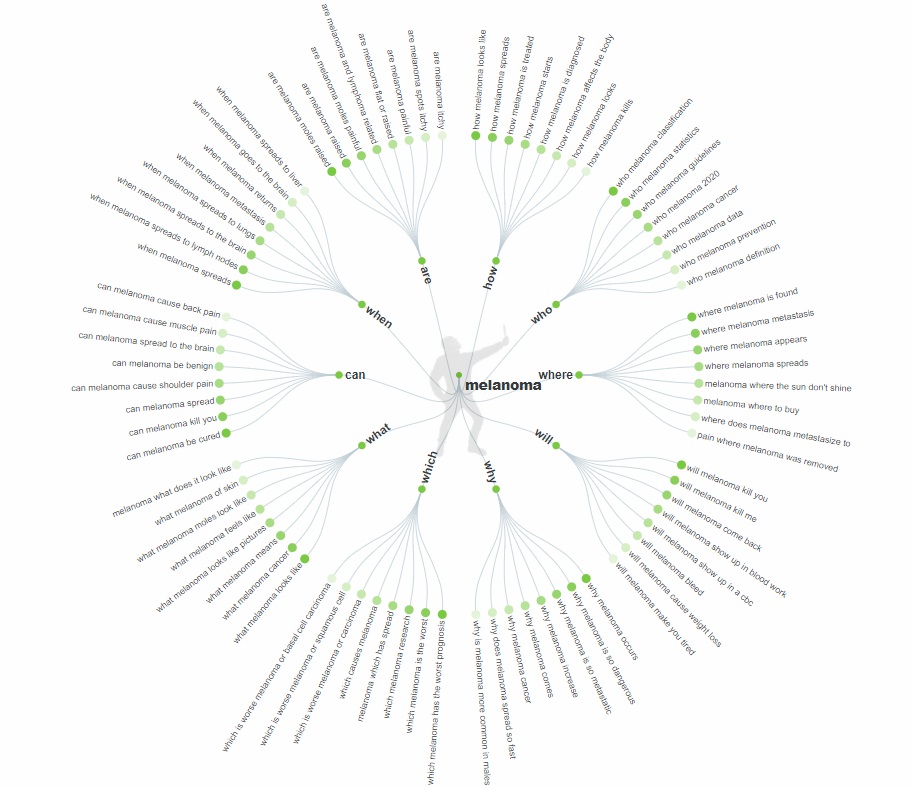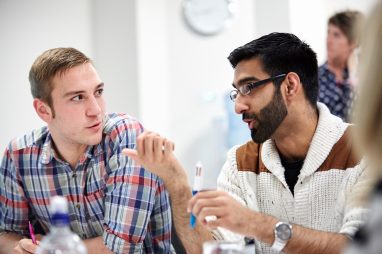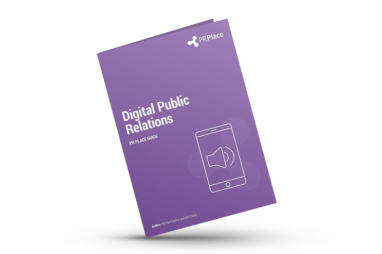Case study: A digital communications strategy to enable melanoma patients to become informed participants in their healthcare

About the author
Martin Flegg Chart.PR FCIPR is a PR professional specialising in internal communication. He is also a guest tutor and assessor for PR Academy on CIPR qualification courses.

This case study by Connor Moonan was developed for a CIPR Digital PR Diploma assignment and has been edited for publication by Martin Flegg. The name Pharma-Co is a pseudonym.
The readily accessible nature of digital channels via mobile devices has resulted in an increase in the use of telemedicine technologies and normalised the consumption of medical information online. With the media reporting that tech companies such as Google are launching initiatives to tackle misinformation online, it is clear that the internet is a valid health information channel for people living with different conditions.
A review by Battineni of published papers concerning online health information concluded that the “internet represents a relevant source of information, but reliability of data that can be obtained by the web is still an unsolved issue,” and that “uncertainties on the quality of online health data may have a negative impact on health-related choices of citizens”.
Melanoma
Melanoma is a form of skin cancer that starts with mutations in skin cells called melanocytes. It is the most serious form of skin cancer because of its ability to spread to other organs rapidly, and the 5th most common cancer in the UK with around 16,700 new diagnoses and 2,300 deaths each year. Treatments for melanoma include targeted therapy which uses drugs or other substances to find and attack melanoma cells that contain certain gene changes (mutations). These include cancer growth inhibitors that are designed to block the signals that tell cells in the body to develop and divide. For example, BRAF inhibitors are used to treat cancer which has a specific mutation in a gene called BRAF.
Improved education and greater awareness of melanoma are needed to reduce incidence rates of the disease and give patients the opportunity to access potentially life-saving drugs. It is critical that melanoma patients are provided with information about prevention, melanoma staging, gene mutation testing and treatments which could support their melanoma journey.
Pharma-Co is a pharmaceutical company involved in the treatment of melanoma. It acknowledges that it has a corporate social responsibility to hold itself accountable to high ethical standards by addressing global health challenges and being a responsible citizen. In this context there is a clear opportunity for the organisation to leverage digital communications to not only empower melanoma patients with information, but also demonstrate tangible action on its commitment to being a responsible citizen by actively tackling misinformation online.
This case study explores how Pharma-Co can empower melanoma patients with reliable and trustworthy information using a digital communications strategy, so that they can become informed participants in their healthcare. Underpinning the strategy is the recognition that it is not possible to empower patients using inaccurate or incomplete information about a disease, digitally or by other means.
Overview of the research methodology
To understand how Pharma-Co could empower an external audience of melanoma patients with information to enable them to become informed participants in their healthcare, the research focused on examining external channels of online communications with three objectives:
- What information is currently available to melanoma patients and are there any information gaps?
- What role do melanoma patients play in treatment and care-related decisions?
- Which information sources do patients use to research their disease, treatment and care?
Each research method was selected due to its potential to produce insights relevant to the three research objectives.
Social media listening
A study by PwC Health Research reported that over 75% of Americans use social media to research their health symptoms. With this insight in mind, Talkwalker was used to source data from online forums, blogs, Twitter and YouTube.
Specifically, Talkwalker was used to collect evidence on stage-III and stage-IV melanoma cancer patient opinions and behaviours. The research focused on conversations relating to melanoma disease information and treatment related discussions taking place online.
The data was also used to create patient personas of UK melanoma patients. This technique was used to understand the needs of melanoma patients and identify the most effective digital communications channels to incorporate into a strategy.
Example of a patient persona

Within the reporting timeframe of January 2020 – February 2021, a pre-determined list of search terms was used to focus the social listening research.
The data collected from social media listening was intended to answer research objective one, two and three.
Online search
Google Health boss, David Feinberg, has said that around 7% of Google’s daily searches are health-related, equivalent to 70,000 every minute. With this insight in mind, research was conducted via online search to collect information on keyword volumes and popular search terms.
To capture data around the volume of monthly searches related to the topic of melanoma and identify high-ranking websites, keyword search tool, semrush.com, was used.
Data around the most common questions and topics of interests related to melanoma online was collected using search engine aggregator, answerthepublic.com. This aimed to provide a framework for auditing content online. In addition, Pi Datametrics was used to map key search terms against 10 pre-identified websites.
Data collected by online search was intended to answer research objective one.
Digital content audit
Drawing on the principles of the Association of the British Pharmaceutical Industry (APBI) Code of Practice and best practice standards in medical writing, a content audit of three websites was undertaken to appraise the quality and validity of melanoma information available online. The websites audited were identified from the online search research: NHS.uk, melanomauk.org.uk and cancerresearch.org.
The content on each website was reviewed against three key questions:
- Is the content accurate valid and verifiable?
- Is the content accessible to a lay audience?
- Does the content encourage patients to continue to educate themselves and support them to play a role in their treatment and care pathway?
The content audit was intended to answer research objective one.
Melanoma Patient Advocacy Group digital audit
To capture insights from the patient community, an audit of leading patient advocacy group (PAG) Melanoma UK’s Facebook and Instagram channel was undertaken.
The audit reviewed published information about melanoma patient advocacy, social media activity, blog posts and a review of comments from the PAG’s page followers.
The data collected was intended to answer research objective two and three.
Journal articles and industry reports
To obtain a deeper understanding of current trends in health information consumption online, peer-reviewed journal articles and industry research reports were reviewed.
This research was intended to answer research objective three.
Advisory Board reports
A review of two advisory board reports was undertaken to extract insights from leading UK melanoma patient advocates and European melanoma healthcare professionals (HCPs).
This analysis was intended to answer research objectives one, two and three.
Analysis and insights from the research
The findings from the analysis were grouped and consolidated to address the three research objectives.
Research objective one: What information is currently available to melanoma patients and are there any information gaps?
Data from the social listening research showed that PAG and patient discussions only accounted for 382 mentions, since January 2020, across patients. When compared with other types of cancer, this revealed that patient online discussions around melanoma are narrower than for other types. Overall, patient discussion focused on awareness of checking moles, new treatment approvals and research findings.
Social listening data revealed an information gap when it comes to treatments, with only 6% of discussions across known influential patients and patient groups being focused on these. Research showed that this gap was met by websites based abroad.
Analysis of the Advisory Board reports showed that there was a demand to up-skill the patient community around Genomics, Staging/Spread, Pathology, Immune system, Molecular lab, Staging classification, Imaging, Medical terminology, medical writing and publications.
Concerns of a professional education gap in the UK, in the context of melanoma diagnosis, was highlighted in one of the Advisory Board reports relating to the UK. For example, one patient was not diagnosed with melanoma despite being seen by a health care provider (HCP) “seven times within a year”.
Social listening research revealed that patient discussion about mutation status was low, with mutations comprising just 7% of the overall advanced melanoma conversation. Of 440 online mentions about mutations, 0 were on public forums. This suggested that patients might talk about mutation-related treatments and symptoms in private channels. In addition, analysis of the UK patient advisory board report revealed that there was a limited awareness of information about BRAF mutation testing, with one patient describing a lack of educational materials.
UK searches about BRAF mutations were dominated by general medical sites based in the US such as Medline and NIH, alongside Wikipedia. This was supported by a statement captured in the UK patient advisory board report which featured a quote from a patient commenting that it was difficult to find UK-based information as “a lot of Google sites pointed to America”.
Research objective two: What role do melanoma patients play in treatment and care-related decisions?
Data from audience profiling and online discussions captured in the social listening report revealed no evidence to suggest that melanoma patients saw themselves as having an active role in the decision-making process for a treatment. In fact, the research indicated that HCPs were the main influence in this process.
Eighty-five per cent of the mutated melanoma discussion identified in the social listening report was focused on treatments. This suggests that the relevant drugs were seen as the key response to mutated melanoma. This finding emphasised the need for any digital communications strategy to remain compliant with the Association of the British Pharmaceutical Industry (ABPI) Code. This sets out principles which pharmaceutical companies must adhere to in communications about treatments and other healthcare matters.
Research objective three: Which information sources do patients use to research on their disease, treatment and care?
Social listening data revealed that online search was the key process for patients to seek information about melanoma treatments. For example, there were 660 monthly Google searches for mutations per month compared to 29 monthly online mentions. This suggested that patients are informed much more by sources of authority on search. In addition, data from semrush.com revealed that there were over 60,000 searches for ‘melanoma’ in the UK each month, supporting the conclusion that search engines were a popular information channel.
When searches were more specific about BRAF mutations e.g. ‘BRAF positive’, the social listening data showed that Pharma-Co and Cancer Research UK ranked highest across patient resources and manufacturer websites, with average positions of 21 and 1 respectively. This suggested that patients were finding the information they needed about this topic directly from the two websites. This finding about the authority of Cancer Research UK corresponded with the outcome of the online search research, which revealed that the charity’s website was a key resource accessed by people using any of the high-volume melanoma search terms e.g. ‘melanoma’.
The NHS, Cancer Research UK and SkinCancer.org websites ranked highest across general melanoma searches. In addition, MacMillan, Cancer Research UK and Pharma-Co ranked highest across ‘stage 4 skin cancer’ searches.
Mutation discussions were dominated by media releases on new studies on melanoma resistance by relevant pharmaceutical companies. This discussion showed that HCPs, patient groups and trade media discussions online were a source of information for patients.
Insights from the UK patient advisory board report and a review of Melanoma UK’s Facebook page revealed a consensus for seeking information on closed Facebook pages, Instagram and Twitter. For example, Melanoma UK’s weekly virtual support meetings and the ‘Melanoma Mates’ Facebook page were considered key channels where patients “can support each other and share medical knowledge”. Twitter was considered a useful channel for articles about melanoma from the medical community. Similarly, podcasts were cited as a source of specialist information as they can “communicate lots of information, quickly…sometimes listening to something rather than reading it is easier.”
Patient advocates on social media were considered important communicators of information by the patient community. For example, the social listening report showed that discussions in November 2020 were led by Love Island reality show celebrity, Molly Mae, encouraging fans on social media to get their moles checked after having a skin cancer experience herself. This finding was echoed by a quote from the UK patient advisory board report when, in the context of recommending Instagram as an information channel for the community, a patient commented that “on Instagram, there is a lady who has been on Love Island. She found a melanoma on her back…she has since had a lot of questions on her Instagram and has a very young audience”.
PAG websites and mobile apps, such as Melanoma’s UK’s ‘Skin Vision App’ were considered credible information resources. This was supported by the online search research, which revealed that PAG websites were often the first port of call for melanoma patients looking for guidance on COVID-19. This suggested that patients trust these groups to provide credible information and support.
Key conclusions from the research
Overall, the research and analysis concluded that:
- An information gap exists when it comes to melanoma treatments and BRAF mutation testing.
- An appetite exists for accessing credible and up to date information about melanoma.
- Digital channels, particularly social media, are viewed as useful information resources for patients seeking to learn more about the disease and share experiences with other melanoma patients.
Strategy, recommendations, ethical considerations and objectives
Based on the research findings, it was recommended that Pharma-Co should pursue an educational disease awareness strategy. A key consideration for the strategy, in the context of combatting misinformation, would be compliance with relevant social media policies and terms and conditions related to health communications, and the ABPI Code as an ethical framework.
Overall, the strategy would aim to provide the patient community with trustworthy medical information, address information gaps identified from the research (e.g. around BRAF mutation testing) and support patients with relevant resources and tools.
Further, the digital communications strategy would only include content that was credible, accurate and, most importantly, not be positioned as a replacement for information from a licensed healthcare professional. In this instance, it would be appropriate for Pharma-Co to include a disclaimer on any digital communications, in line with the ABPI Code, to encourage people to “speak to your healthcare professional for more information”. In addition, including links to external stakeholder resources – like the NHS – in any Pharma-Co created content would serve to strengthen the trust patients have in their healthcare professional.
A multi-channel strategic approach was recommended, focusing on online search and social media, as the research had clearly shown that these were key channels used by melanoma patients seeking information.
All content used in the strategy would benefit from alignment to the best practice framework published by leading European PAG – the Melanoma Patient Network Europe – which considers trustworthy medical information for patients to be:
- Accurate, valid and verifiable
- Accessible: “If you can’t put it simply, you don’t understand it well enough”
- Encouraging to patients to continue to educate themselves to increase their understanding and ability to digest content and proactively ask questions
Based on this strategy, three digital communications objectives were developed.
Objective One
Enhance melanoma patients’ understanding of melanoma by creating a dedicated, SEO-optimised, disease awareness website featuring a blend of content and formats about melanoma prevention, diagnosis, treatments and BRAF mutation testing.
Objective Two
Engage with and support the melanoma community by partnering with one patient advocacy group to co-create a digital educational toolkit on melanoma hosted on Pharma-Co owned and PAG owned channels.
Objective Three
Raise awareness of melanoma prevention and mutation testing by partnering with a relevant social media influencer to launch educational content across a blend of earned and paid media tactics.
Taking action
With the National Audit Office in the UK estimating that there were up to 740,000 ‘missing’ urgent GP referrals for suspected cancer in England during the period of the pandemic up to September 2021, it has never been more important to provide accurate medication information to patients online, particularly against a backdrop of restricted access to GPs.
Following the research, Pharma-Co took action to progress the recommendations and objectives.
A web-based application was created to host information about the melanoma patient pathway and the four different stages that a melanoma patient would typically go through from diagnosis, through to referral for a biopsy, treatment and mutation testing.
The web app featured a broad selection of content about the disease, informed by insights from patients about the types of information and features they would want from this online tool. One of the key points that the patient community raised, was the feeling of being emotionally overwhelmed when given their initial diagnosis by a healthcare professional. This meant they were not able to think about or ask the questions they wanted to, during a time constrained consultation.
As a solution, Pharma-Co created online checklists with suggestions for questions that patients might want to ask that they could download and take into a consultation with their oncologist.
Engagement with the patient community was undertaken through advocacy groups to understand how other educational online information tools could be created. One key finding was that complex and detailed written information in the form of online articles and leaflets was not helpful for patients, or those at risk of developing a melanoma, as they often had little medical knowledge.
As a solution Pharma-Co looked to social media, and in particular Instagram, to provide more visual information such as animations to explain the science behind the BRAF mutation. Feedback from advocacy groups was that keeping things simple and visual was a more engaging way for patients to receive information, connect with it and take what they have learned into conversations with their GP or oncologist, if they were concerned about a mole on their skin
Connor Moonan – What I learnt from completing my Digital Diploma assignment

“I work for an agency, which is always very busy. The course taught me the importance of taking the time to step back and make sure that the right amount of research and planning is done to properly inform proposal recommendations for my clients. Having a robust strategic framework on which to base recommendations for PR activity is so important.
A few years ago, I did a Chartered Institute of Marketing course, which was a bit similar to my Digital Diploma in that it included academic models and frameworks which inform practice. It’s easy to forget about things like that in day to day working. Completing my diploma was a reminder that academic theory, models and frameworks are important and can really help with the structure of recommendations for PR activity.
I’m really interested in social media, so it was great to discover theories such as the theory of social technographics. I used this in my assignment. It’s about imagining a ladder, where each rung of the ladder represents a different type of category of social media user. So, as spectators, collectors, influencers and creators.
In the context of my assignment, the creators and influencers were the pharma companies and patient advocacy groups, whilst the collectors and spectators were patients needing information. Using the theory to think about this helped me to identify the different audiences for the web app we developed to improve the accessibility and impact of information about melanoma for patients.
I’ve also used this theory in my work with other clients as well. It has made me think about who the audience is and who I am targeting and how to tailor my communications approach accordingly.”


